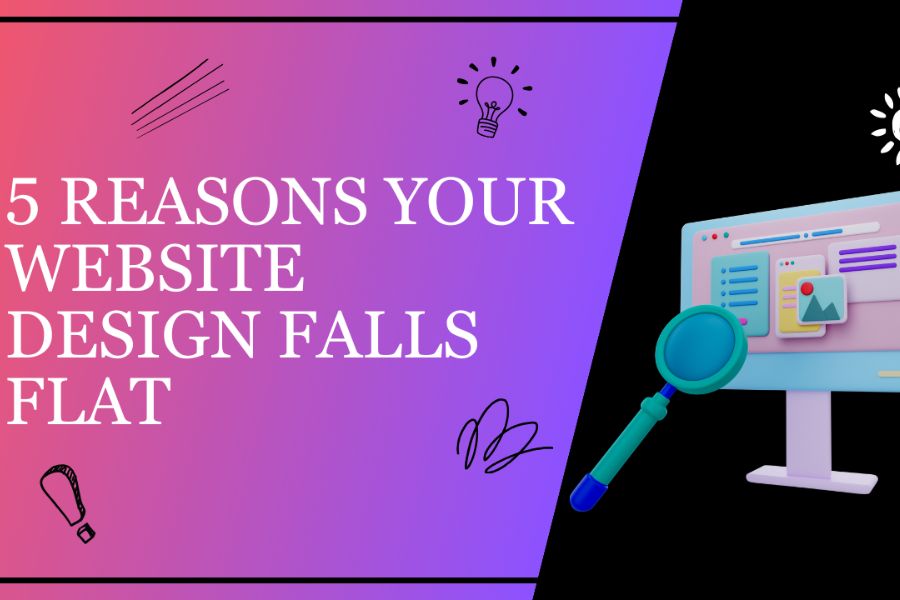In digital marketing, your website is the heartbeat of your online presence. Designing it correctly is paramount to your success. However, it’s all too easy to fall into the trap of typical web design mistakes. In this article, we’ll explore seven such blunders and provide solutions to help you steer clear of these design mishaps. To stay updated with the latest web design tips and tricks, consider subscribing to revenue weekly from web design services in India!
1. Neglecting Mobile Friendliness
Your website’s ability to adapt to mobile devices is crucial. In a world where data is precious, slow-loading websites are a big turn-off for users and search engines. If your website isn’t mobile-friendly, you risk losing up to 80% of your visitors to mobile-friendly competitors.
Solution: Ensure your website is responsive and user-friendly on smartphones and tablets. Make text legible without zooming, simplify navigation, and streamline the checkout process for mobile users.
2. Confusing Navigation
One of the most common web design mistakes is offering a confusing navigation experience. Users crave quick and easy access to information. They will only stick around if they are able to find what they need.
Solution: Logically arrange the navigation on your website. Ensure that pages are located in the expected locations for users and eliminate any erroneous menu placements or missing pages. Users are engaged and stay on your website longer when the navigation is well-designed.
3. Embracing Stock Templates
Your website should be uniquely designed to differentiate you from the competition and represent the character of your brand. Utilizing pre-made templates makes your website appear generic and can turn away visitors.
Solution: Spend money on bespoke web design services in India to develop a standout online identity that complements your business. Make a statement and create an impression on your audience by standing out.
4. Extended Load Times
A slow website is a serious web design error. People expect prompt responses and abandon pages that take too long to load.
Solution: Improve the speed of your website so that it loads in under two seconds. To provide a fluid surfing experience, compress pictures, employ effective code, and take advantage of caching.
5. An old and unsafe website
Customers frequently form their opinions of your company based on your website. Your business will be negatively affected if your website has broken links, stale information, and outdated design components.
Solution: Consistently add new information and contemporary design aspects to your website. To foster confidence and safeguard user data, ensure the website’s security.
6. Lackluster Call to Action (CTA) Buttons
Effective calls-to-action (CTAs) are pivotal for encouraging user interaction. Whether you want visitors to subscribe, follow, or contact you, compelling CTAs are necessary.
Solution: Incorporate CTAs strategically throughout your website. Make them actionable, enticing, and visually appealing with attention-grabbing colours. Indicate that they are clickable to guide users towards conversion.
7. Disregard for User Experience
The success of your website depends on the overall user experience. Visitors will depart if it is frustrating or unclear.
Solution: Constantly enhance user experience through usability testing, user feedback analysis, and appropriate alterations. Give your audience’s smooth and delightful journey top priority.
The layout of your website is crucial to your digital marketing initiatives. Design a website that engages your audience and produces significant results by avoiding these common web design errors and using the suggested fixes. To guarantee that your online presence stands out and flourishes in the cutthroat digital environment, consider collaborating with Mandy Web Design, a reputed web design company in India.
Frequently Asked Questions (FAQs)
Why is mobile-friendliness so crucial for a website?
Mobile-friendliness is crucial because many internet users access websites on mobile devices. If your site isn’t optimized for mobile, it leads to a poor user experience, potentially resulting in high bounce rates and lost visitors.
What are some common indicators of confusing website navigation?
Signs of confusing navigation include:
- Non-intuitive menu structures.
- Broken or missing links.
- Inconsistent labelling.
- A need for clear paths to important content.
Users should easily find what they’re looking for without frustration.
Why should I invest in custom web design services instead of stock templates?
You may develop a distinctive online identity that supports your brand thanks to custom web design. Your website may appear generic if you use stock templates, making it more difficult to stand out in the congested online space.
How can a slow-loading website affect my business?
A slow website can lead to higher bounce rates, lower search engine rankings, and a poor user experience. Visitors expect fast-loading pages; if they don’t get that, they may leave and choose competitors.
What is the significance of SSL certificates for website security?
SSL certificates guarantee the encryption and security of user data transmission between your website and them. A website with an SSL certificate secures user data and fosters customer confidence because visitors’ browsers display the padlock icon, which denotes a secure connection.
How can I improve the effectiveness of my CTAs?
Make sure your CTAs are action-oriented, clearly describe the advantage to the user, use contrasting colours to make them stand out, and make them simple to click on to increase their effectiveness. Conversions and user engagement can both be dramatically increased by effective CTAs.
Which best practices should I follow while testing my website’s usability?
During usability testing, actual users are observed interacting with your website. Best practices include:
- Establishing precise test objectives.
- Selecting a diverse set of testers.
- Documenting user interactions and feedback.
- Utilising this information to improve the look and functioning of your website iteratively.


